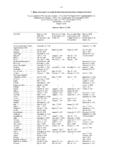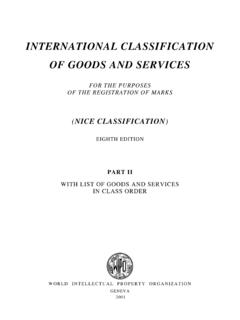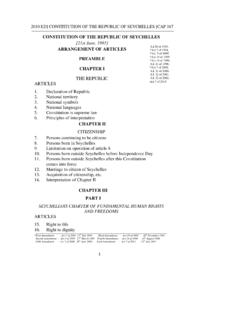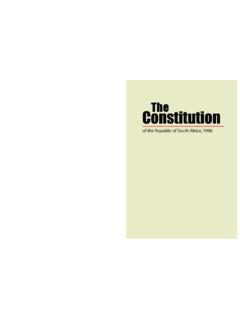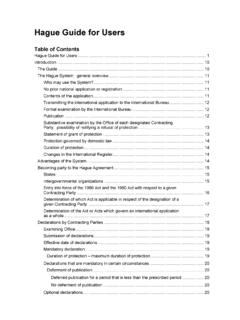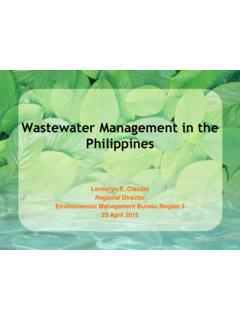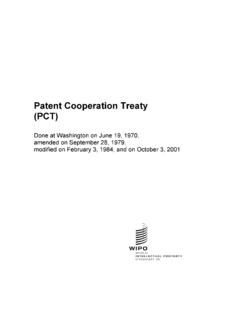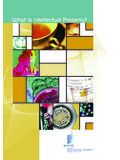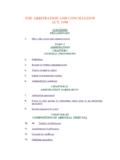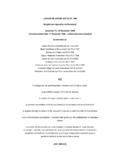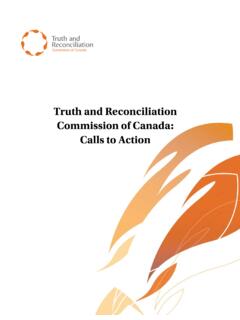Transcription of Documenting Traditional Medical Knowledge - WIPO
1 Documenting Traditional Medical Knowledge Prepared by Ryan Abbott, , , March 2014 ii World Intellectual Property Organization, 2014. Certain rights reserved. wipo authorizes the partial reproduction, translation and dissemination of this publication for non-commercial and non-profit scientific, educational or research purposes, provided that wipo , the publication and the author are properly identified and acknowledged. Permission to substantially reproduce, disseminate and/or translate this publication, or compile or create derivative works therefrom, in any form, whether for commercial/for profit or nonprofit purposes, must be requested in writing.
2 For this purpose, wipo may be contacted at under Contact us . Disclaimer: This publication was prepared by Dr. Ryan Abbott. It does not necessarily represent the views of wipo or any of its Member States. This publication is not a substitute for legal advice. Its purpose is limited to providing basic information. Readers are invited to consult also the Consultation Draft of the World Intellectual Property Organization Traditional Knowledge Documentation Toolkit, available at: , and the Background Briefs prepared by the wipo Secretariat, available at: iii CONTENTS Executive Summary .. 1 List of Abbreviations .. 2 I. Introduction to Traditional Medical Knowledge .
3 3 1. Traditional Knowledge .. 3 2. Traditional Medicine .. 3 Traditional Chinese Medicine (TCM) .. 4 3. Complementary and Alternative Medicine .. 4 4. Characteristics of Traditional Medicine .. 4 5. Importance of Traditional Medicine for indigenous Peoples and Local Communities .. 5 CordyCeps Sinesis in Tibet .. 5 Magic and Medicine in Zimbabwe .. 6 II. Traditional Medicine Use .. 7 1. Traditional Medicine Worldwide .. 7 2. Safety Issues .. 7 Good Manufacturing Practices .. 8 Misuse of Ephedra Sinica in the United States of America .. 9 3. Big Business and New Drug Development .. 9 Malaria and Herbal Medicine .. 10 4. Exporting Traditional Medicine .. 11 5. 12 Turmeric in the United States of America.
4 12 III. National and International Policies on Traditional Medicine .. 13 1. Beijing Declaration .. 13 Excerpts from the Beijing Declaration .. 13 2. National Policies on Traditional Medicine .. 14 3. Cultural Polices and Human Rights .. 14 Excerpts from the United Nations Declaration on the Rights of indigenous Peoples .. 15 IV. Regulation of Traditional Medicine .. 16 1. Data Exclusivity .. 16 2. Regulation in the United States of America .. 16 Fusing Science and Tradition .. 18 3. Regulation in the European Community .. 18 4. Regulation in China .. 20 iv 5. Regulation in India .. 21 6. Regulation in Brazil .. 21 7. Traditional Systems of Regulation .. 22 V. Intellectual Property and Traditional Medicine.
5 23 1. Intellectual Property Rights .. 23 Hot Yoga Controversy .. 24 2. Obstacles to Protecting Traditional Medicine .. 25 3. Evolution of Intellectual Property Protection .. 26 4. Sui Generis Regimes .. 27 5. The Public Domain .. 28 Kava .. 29 6. Ownership of Intellectual Property Rights .. 29 Mijikenda Ownership of Traditional 30 VI. Considerations for Documenting Traditional Medicine .. 32 1. Benefits and Risks of Documentation .. 32 The Traditional Knowledge Digital Library (TKDL) .. 33 2. Additional Considerations for Documentation .. 33 3. Traditional Knowledge Databases .. 35 4. External Collaborations .. 36 University of Illinois at Chicago Benefit-Sharing Policy .. 37 Controversial Collaborations.
6 38 VII. Practical Strategies for Documentation .. 39 1. Before Documentation .. 39 Lost Opportunities in Brazil .. 40 Pre-Documentation Checklist .. 43 2. During Documentation .. 43 During documentation Checklist .. 44 3. After Documentation .. 45 First Nations Confidentiality Management .. 46 Post-Documentation Checklist .. 47 About the Author .. 48 Acknowledgements .. 48 1 EXECUTIVE SUMM ARY Traditional Medical Knowledge is experiencing increased attention worldwide in light of global health care demand and the significant role of Traditional medicine in meeting the public health needs of developing countries. Traditional medicines already comprise a multi-billion dollar, international industry, and the biomedical sector is increasingly investigating the potential of genetic resources and Traditional Knowledge .
7 Documenting and protecting these medicines is becoming a greater priority. Traditional Knowledge has historically been at odds with modern intellectual property systems designed to protect innovations such as new pharmaceutical drugs. However, as the financial value of many forms of Traditional medicine becomes recognized, Traditional Knowledge holders and nations rich in genetic resources are arguing for greater protection through non-conventional systems of intellectual property protection. Traditional Knowledge holders are increasingly demanding fair and equitable distribution of benefits from the commercialization of Traditional medicine, as well as the prior informed consent of indigenous peoples to prevent misappropriation.
8 Many problems associated with the protection of Traditional Medical Knowledge lack clear solutions. In attempting to protect Traditional medicine, Traditional Knowledge holders are confronted by a confusing and diverse group of national and international policies, regulatory systems designed primarily to accommodate pharmaceutical medicines, safety and efficacy concerns, and challenges to ownership. This text is designed to assist Traditional Medical Knowledge holders, government representatives and third-party collaborators to think about issues of intellectual property law specifically related to Traditional Medical Knowledge . It is not intended to provide legal advice, but rather to help stimulate thinking about Traditional Knowledge and to provide illustrative case studies.
9 There is no generic way to protect Traditional Medical Knowledge . Traditional Knowledge holders should carefully consider identified community goals for the use of Traditional medicine and the risks and benefits of documentation. Whether Traditional Medical Knowledge is documented can have far reaching consequences on intellectual property protection, commercialization and promotion of Traditional medicine, regulatory submissions and interactions with collaborators. It is important that Traditional Knowledge holders be adequately informed to safeguard their reputations and interests when interacting with third parties. Hopefully, this text will help Traditional Knowledge holders better understand the issues related to Traditional medicine and intellectual property and make informed decisions about the best use of their Knowledge .
10 2 LIST OF ABBREVIATIONS ABS Access and Benefit-Sharing CAM Complementary and Alternative Medicine CBD Convention on Biological Diversity CGEN Council for the Management of Genetic Patrimony (Brazil) CSIR Council of Scientific and Industrial Research (India) EMA European Medicines Agency EU European Union FDA Food and Drug Administration (United States of America) GAO Government Accountability Office (United States of America) GMPs Good Manufacturing Practices GRs Genetic Resources INDECOPI National Institute for the Defense of Competition and Intellectual Property Protection (Peru) IP Intellectual Property IPC International Patent Classification IPO International Patent Office IPR Intellectual Property Right NCCAM National Center for Complementary and Alternative Medicine (United States of America) NDA New Drug Application SATCM State Administration of Traditional Chinese Medicine (China) SFDA State Food and Drug Administration (China) SIPO State Intellectual Property Office (China)
